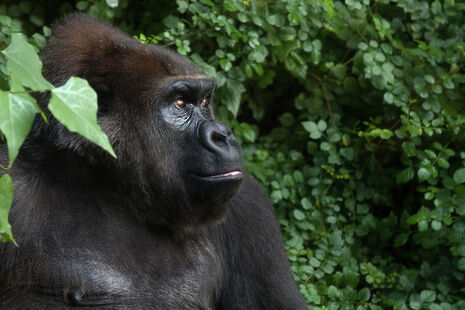In a post-ironic world, who or what is Harambe?
The insincere hyperbole with which the gorilla is mourned has something to tell us about ourselves, suggests James Snell

Sometimes, deaths can be positive events. They bring people together in mourning and in reminiscence. In the case of the famous, they can unite the world in commemoration of great talent, excellent work, and, lost potential. We have already seen it in 2016, the year which has brought the early deaths of so many greatly loved figures: Prince, David Bowie, and Alan Rickman.
The year itself appears at times to be little more than one long obituary page, a seemingly endless roll call of the talented, the magnetic, the once essential – all of them now lost to the ages. Indeed, the popular perception is that famous people are dropping like flies, that the year itself has been written like a particularly bloody drama.
But one death which refused to pass 'gentle into this good night' was that of an animal. Although I write this almost five months on, the surrounding arguments wage on, with a number of law students recently organising a 'candlelight vigil' in memoriam.
In what has turned out to be a culturally, socially and intellectually significant event, a toddler fell into the gorilla enclosure at Cincinnati Zoo, where he encountered Harambe, a 17-year-old gorilla and one of the enclosure’s three inhabitants. Zoo authorities said they feared for the child’s life and Harambe was shot dead.
So far, so ordinary: the sad result of an avoidable accident. But there was something different here. Not only was the entire incident caught on video (almost inevitable in this day and age), but a lively ethical debate, one tinged with real emotion, also quickly took over. Was the killing justified? Was it the only option? Did Harambe really have to die?
Biologists weighed in, and ordinary people in their millions gave their opinion. Many zoologists said that it was, regrettably, necessary for Harambe to have been killed. This was disputed by animal rights activists and many others, for whom it was an act of immense callousness, a statement of humanity’s profound arrogance.
Soon this discussion, earnest though it initially was, took on a new character. The gorilla was mourned, eulogised, missed – but all with an ironic intonation. Soon, jokes began to appear; Harambe became both an internet meme and a cultural event.
That’s when people started faking transcripts to suggest that Hillary Clinton ordered Harambe’s murder. Trump supporters were photographed holding up signs reading: "Hillary Killed Harambe!" Things soon reached Ted ‘Zodiac Killer’ Cruz levels: near total ubiquity online, yet with ever diminishing comic value. The joke wasn’t funny anymore.
This fact did nothing to reduce the number of Harambe-related gags and references, however. Instead they became yet more pervasive, a constant quasi-comic drumbeat underlining the general absurdity of social and internet media. But Harambe, and the attendant fame caused by his early death, is more significant than that.
As well as being a fairly tired joke, the Harambe meme is interesting because it is effectively post-ironic, for people who initially took part for facetious reasons ended up almost caring about the guy – that species of jokey, sardonic knowingness that has become the norm. Post-ironic sincerity is the new sarcasm.
I would contend that not everyone who films themselves walking into the rain and falling to their knees while plaintively calling a dead gorilla’s name is doing it for a joke. The knee-jerk reactions, the constant mentions, the feigned upset – all of this has an impact, eventually.
In effect, it becomes less performative and more sincere through repetition: both more and less funny as time goes on, but no less entertaining and even fulfilling, in a strange way. Perhaps it’s a way of making sense of the randomness of things – a cross-species memento mori dressed up as a morality tale, or a reminder for the modern age.
And all of this has led to what was a fairly petty – if tragic and ethically complex – story becoming a global phenomenon. The sincerity, post-ironic or uncomplicated, has returned. And though the joke itself may be a stale one, it is not, unlike Harambe, quite dead yet.
He was even referenced by US Green Party presidential candidate Jill Stein in a wider comment on animal rights. (Particularly amusing because, at one point, Harambe, listed as a candidate, was faring better in the polls than Stein.)
On Twitter, where the mundane can gain unprecedented significance, Harambe lives on. Cincinnati Zoo received no end of tweets, leading them to eventually delete their account, unable to cope with the constant jokes, and the no-longer humorous insinuations.
In reaction, one person, or perhaps many people, shot back. Quick as a flash, almost without thought, the reference has become almost instinctive.
Quite whether this pop culture prominence will translate into something more concrete remains to be seen. But the story on social media is a different one: online, there is no end in sight to the continued production and propagation of Harambe memes. Indeed, they have become a cultural staple. They have become dull and mainstream in a peculiar way.
Initial tragedy has been transfigured into comedy and then into semi-tragedy once again. Harambe has attained a remarkable cultural prominence. What this means for the future is still to be seen – if it means anything at all.
 Interviews / You don’t need to peak at Cambridge, says Robin Harding31 December 2025
Interviews / You don’t need to peak at Cambridge, says Robin Harding31 December 2025 News / Cambridge academics stand out in King’s 2026 Honours List2 January 2026
News / Cambridge academics stand out in King’s 2026 Honours List2 January 2026 Comment / What happened to men at Cambridge?31 December 2025
Comment / What happened to men at Cambridge?31 December 2025 News / Unions protest handling of redundancies at Epidemiology Unit30 December 2025
News / Unions protest handling of redundancies at Epidemiology Unit30 December 2025 News / Varsity’s biggest stories of 202531 December 2025
News / Varsity’s biggest stories of 202531 December 2025









